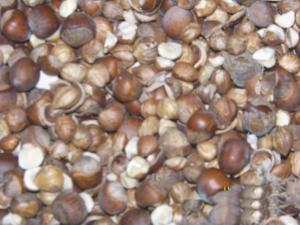2010 - Volume #34, Issue #6, Page #30
[ Sample Stories From This Issue | List of All Stories In This Issue | Print this story
| Read this issue]
Mechanical Cracker Speeds Hazelnut Processing
 |
 |
"Commercial processing for hybrid hazelnuts was not available so we've had to develop machines to husk, sort and crack the nuts, then clean and size the kernels," says Erickson. "Our machines handle anything from the smallest hazelnut to the largest walnut."
A retired IBM employee, Erickson is developing high oil hazelnut seed stock (60 percent) for biofuel and other markets. There's also a high demand for black walnut kernels and oil; yet millions of black walnuts go unused every year, largely because they are hard to process. He is confident his equipment could be used equally well on them and be the basis for a new, rural cottage industry.
Erickson has a prototype husker and cleaner that can be built in most shops. He has applied for patents on his Crack-M-All nutcracker and is in the process of applying for his Sort-M-All nut sizer/sorter. Both are complex and highly engineered machines.
"I am still refining some design points on the Sort-M-All, but the prototype is fully operational," says Erickson.
He uses a mechanical hammer that cracks nuts against an anvil. The anvil-to-hammer opening can be adjusted for the type and size of nuts being cracked. Three cams offer 1/16-in., 1/8-in. and 3/16-in. hammer travel. The hammer travel can be changed in about 10 min.
Erickson has sized the cracker for small farm-sized operations and for larger commercial use. A 12-in. input hopper holds about 10 lbs. of nuts and it will process about 200 lbs. of nuts per hour. A larger hopper can automatically keep the input hopper full.
"I am currently driving the cracker with a 1/2 hp, 1,725 rpm motor with speed reduced 3:1 for hazelnuts," says Erickson. "It needs a larger motor for black walnuts."
Before cracking, hazelnuts need to be sorted into size classes. Erickson's Sort-M-All is designed to do just that. While Erickson hesitated to give details on it before patent submission, he did describe what it does.
"It can be adjusted in minutes to sort the nuts into a number of sizes as desired by the operator before cracking. I use 7," he says. "It can also be used to sort the cracker output to remove husk and shell debris and sort kernels for final cleaning and marketing. This step enables the smaller nuts to be easily removed from nuts going to the in-shell market. Cracked black walnuts pieces can also be sorted into size classes for the required recracking."
Erickson plans to develop a feeding system for the Sort-M-All. Currently, it can sort about 160 lbs. of nuts per hour with output from 80 to 320 lbs. or more per hour.
Prices have not yet been established for either nut processing machine.
Contact:á FARM SHOW Followup, Norm Erickson, 1303 N.E. 5 Ave., Rochester, Minn. 55906 (ph 507 282-7365; cell 507 319-4085; hazelnutsource@gmail.com).

Click here to download page story appeared in.

Click here to read entire issue
To read the rest of this story, download this issue below or click here to register with your account number.




